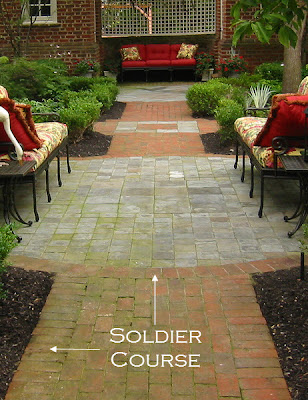This is my first post in what I hope will be an ongoing series of Landscape Design 101’s on popular styles and terms used. My goal is to provide the basic knowledge for novice designers to either do a project themselves or talk to a professional installer/designer about what they would like for their home. If there are any particular topics you would like for me to feature, let me know.
Four Basic Brick Patterns
 |
| Running Bond is one of the most common patterns used. It is easy to lay and works great in areas that are tricky shapes . |
 |
| This is a very simple pattern, but not commonly used. I could see this simplistic pattern used in a modern landscape, compared to a more traditional space. |
 |
| Depending on the size of your brick this can be done with two or three bricks. |
 |
| In comparing to the 45 degree herringbone, you can see that this method is easier to lay, and would require much less cutting. |
Four Types in Use
Now, here are examples of the four different types of patterns used in the landscape. You can see the different types of patterns can be used in may different types of landscape styles. (I am missing an example of stacked bond, but will keep looking.)
 |
| Basket Weave that transitions into Running Bond. Image from Flickr. |
A Little bit more on Bricks.
There are two main types of bricks (handmade and factory), and within those two types there are many different color and finish options. I typically prefer handmade bricks that have a little age and quirkiness to them, but you if you do your research you can find some factory bricks that look handmade.
There are also two main type of installation methods for brick walkways, driveways and patios; Wet and Dry. This is totally your personal preference for installation and aesthetic. Wet means it is set in concrete on a concrete base. Dry means it is on a stone aggregate base and is kept in place by using and edger (Metal or plastic). The joint are then filled with sand (I prefer using a poly-sand). All the images above are dry, but below are two examples of wet. Which ever way you choice, make sure the sub-base is sufficient for the installation method, planned use and climate.



I have noticed you don’t monetize thinkingoutsidetheboxwood.com,
don’t waste your traffic, you can earn extra bucks every month with
new monetization method. This is the best adsense alternative for any type of
website (they approve all sites), for more details simply search
in gooogle: murgrabia’s tools